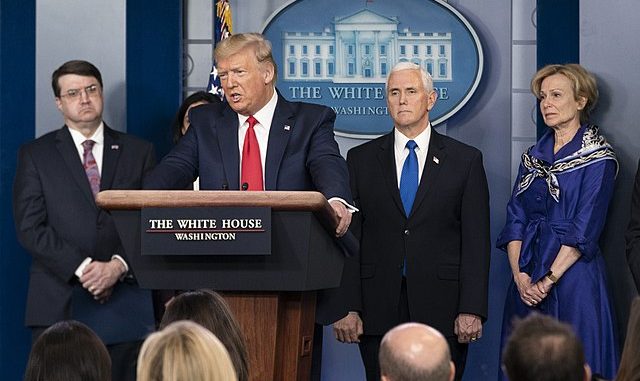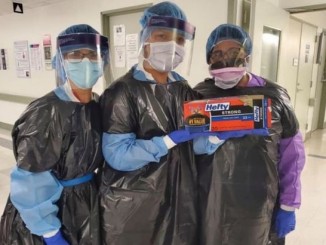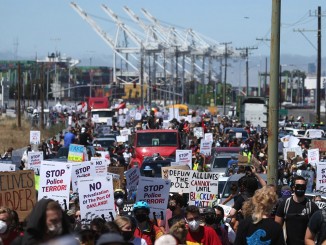
Faced with the horrific coronavirus pandemic, with no idea of its potential scope or how long it could last, it is absolutely clear what the U.S. government’s priorities are. The priority has been to support and protect the financial health of the corporations and banks. Initially they were preoccupied with talking to financial experts about the health of the stock market, not to doctors and epidemiologists about the health of the majority of the American people.
Instead of doctors and scientists coordinating the response to the pandemic, Trump has been center stage. At daily press briefings, Trump has to start by saying what a great job he is doing. This was followed by Vice President Pence and a supporting cast of government doctors and scientists whose role is to first praise Trump’s “leadership” and then to make vague pronouncements about the government’s response to the current situation. Trump has consistently lied, minimized the threat of the virus, and repeatedly said testing was available when none of this was true. Trump has taken no responsibility for the botched approach to preparing for the pandemic, and he blames China or initially called it a Democratic hoax.
The U.S. Healthcare System Was Not Prepared To Respond To This Crisis.
Private healthcare insurance means decisions are made on a corporate profit-making model not a health-care providing model. Thirty-seven million people have no health insurance at all. Millions of others have bare bones insurance, which means they have to pay high co-pays or out of pocket costs. And people with the best healthcare plans often have to wait a considerable amount of time to see a doctor or to schedule an operation or other procedure.
Today most U.S. hospitals are understaffed, lack adequate supplies, equipment and enough beds. Public health care has faced drastic cuts – 18% in California since 2008. Trump’s administration has accelerated cuts to the budgets and personnel of the federal agencies that oversee healthcare and emergency preparedness. Now, with the prospect of tens or hundreds of thousands of new patients, the U.S. healthcare system is in crisis. The obvious solution would have been to address these shortcomings and quickly develop a coordinated national response. This would have meant centralizing and coordinating resources at the national level to maximize efficiency in responding to local needs and demands.
Government Response Is Too little And Too Late
But just the opposite has been the case. The Trump administration has dragged its feet, first denying that this was really a problem, then, when deaths began to mount in the U.S. and around the world, it could no longer hide from reality. For weeks, the Trump administration didn’t come out with any specific proposals or guidelines to follow. Even something as simple as “social distancing” was too complex for his “national brain trust”. After some state health agencies halted concerts and other large gatherings, the federal government then said no more than 25 people should gather together, changing it to ten people the next day. And as to giving support to state’s and local governments, it wasn’t until March 18 that Trump announced the release of federal government stockpiles of equipment. But this announcement was not accompanied with proposals for who would get these resources and how they would be deployed.
It is impossible to devise a response when the extent of the presence and level of infection remains unknown. In downplaying the need for testing, Trump claimed it wasn’t really necessary. He demonstrated this by refusing to be tested, even after his exposure to at least one infected person was documented. Then, it became clear to all that testing was essential – with reported deaths from the virus and the report that a cruise ship, off the coast of California, with thousands of people on board had passengers with the virus. But almost no testing was ordered or administered. And it was very obvious that test kits were in short supply. Testing was only being done through the national CDC center. In response to this lack of testing kits, in some centers of infection, like the area around Seattle, Washington, hospital and university labs began to develop and use their own testing kits. Finally by mid-March confirmatory testing (which is used in determining the spread) was no longer required to go through the CDC. As of March 17, there were only 88 public testing laboratories offering testing across the 50 states. But as of the beginning of this week only 40,000 tests have been completed in the U.S. In contrast to this, South Korea, from the beginning of the outbreak, has been regularly testing 10,000 people, or more, per day.
Trump’s “Plan” Leaves State And Local Governments On Their Own
While the Democrats were quick to criticize Trump’s lack of response, most governors waited before enacting their own plans of action. As a result, state and local health departments have been scrambling, as Trump made it clear on March 19 that he has no intention of centralizing the dispersal or mandating the production of needed equipment, but instead said this was a problem the states needed to solve themselves.
Different local and state governments have proposed completely different policies. Closing schools took weeks to become final across the country. Sheltering at home was the policy in some places, but not in others. Large gatherings were canceled, often a few states at a time, until major sports franchises shut them down. Some states and cities ordered gyms, bars and restaurants to close but others didn’t. In Miami as of March 18, the TV news showed thousands of people on crowded beaches enjoying spring break, and there, restaurants and bars remained full of people in close quarters. With the schools closed, workers need to stay home with their kids, but how are they supposed to pay their bills? In a society where so much is privately owned and run there is little planning or coordination. Instead, people have been left to fend for themselves. The response has often been chaos with people who have enough money, buying food and supplies – leaving store shelves empty. But there is no plan to make sure that other people in need will get enough food or other necessary supplies.
What Economic Measures Has Congress Proposed?
Congress is still negotiating how to get trillions in the form of grants, loans, and outright gifts to the airlines, hotels, casinos and cruise ship businesses and other businesses and banks. They are also discussing token relief for U.S. workers. The federal government has announced various proposals but the specifics are unclear. They say that there will be no evictions for non-payment of rent in federal housing, no interest on student loans collected, and no federal tax payments due for at least two months. But most people don’t live in government housing. Supposedly, some workers who have to miss work because they are sick will get paid for two or more weeks, but this doesn’t include large companies and smaller ones, which can be exempted if they claim hardship. This could leave out 19 million workers.
Congress is trying to calm people’s fears by giving at least one payment of $1000 to most Americans, saying this amount may be increased in the future. But what is $1000 if you have lost your job, lack medical insurance and can’t pay your rent? And what about the many Americans who live paycheck to paycheck — how will they feed their families? Again, some local and state governments are stepping in, declaring rent moratoriums during the crisis and preventing evictions. But how are people supposed to pay their bills after missing so much work?
Competition and Privilege
Instead of global collaboration to come up with vaccines or anti-viral drugs, there is the usual capitalist competition by the different drug companies supported by the different national governments. The U.S. didn’t try to purchase testing kits from other countries, even though they knew they had an inadequate supply. They preferred to wait in order to give the U.S. drug companies the opportunity to profit from the crisis. The situation at the hospitals is a disgrace. The private hospitals have made record profits by cutting staff and non-profitable services. Now they don’t even have the most basic protective gear for hospital staff. Instead of ordering the companies that make masks to gear up production, Trump bragged at his press conference on March 18 that the government was changing the regulations so that construction companies could avoid liability if they gave masks used in construction work to hospitals, even though these masks would not provide the same protection as those made for hospital use.
Professional basketball players, politicians, and corporate executives have been able to get tested immediately and get their results back the same day. The federal government has now said testing is free. But who can get a test? They are still not widely available. And even if you do get one, it can mean waiting from 5-7 days before you get a result. Many workers, who don’t have paid sick time or the kind of jobs where they can work from home have been expected to continue going to work. They are being asked to risk their health to produce cars or other things not needed to respond the healthcare crisis. And, the government is continuing ICE raids against undocumented immigrants, making many too fearful to consider getting tested or seeking health care.
Social Distancing Should Not Mean Social Isolation
As in every crisis we face, it is ordinary people who rise to the occasion and form a community support system. People are setting up digital groups of friends, family and co-workers to stay in touch. Neighborhoods are setting up networks to take care of shopping and care for the elderly or sick. Workers in the public sector and healthcare workers have continued to work during this chaos, even if it has meant risking their own health. School workers have gone to the schools to prepare meals for school children so they won’t go hungry if the schools are closed. Teachers are calling their students to make sure they are OK. Artists also have joined in. YoYo Ma, the famous cellist and other musicians are playing “comfort music” to watch digitally. Museums are putting collections online and actors are providing theater for people to watch digitally.
Profits Or Peoples Needs?
The coronavirus poses a serious health threat to humanity. This has been magnified by the capitalist system that presents a daily threat to our lives and our health. The failure to respond to the impending pandemic in countries around the world has exposed the functioning of a system that serves the interests of the wealthy 1% at the expense of the well-being, health and lives of the 99%.




